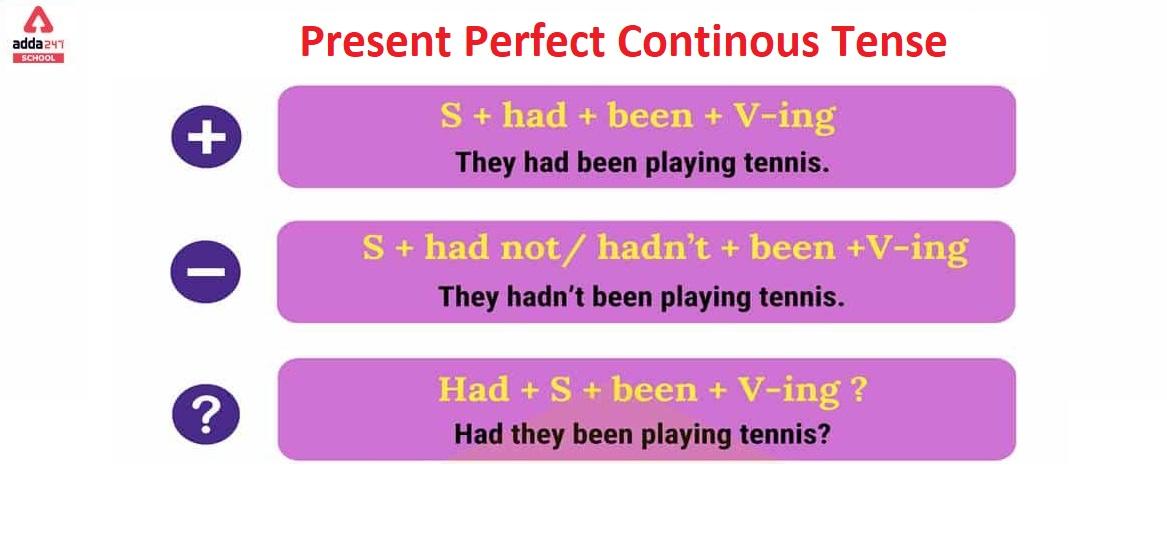Past Perfect Continuous Tense
In most sentences, the past perfect continuous tense is used to represent an action that began in the past and continued until a given point in the past. It is also known as the past perfect progressive tense since it refers to an action that has occurred in the past. In everyday life, we frequently use this tense. However, it is sometimes misused. This tense is essentially a “past in the past” tense. As a result, we are going to discover more about the its structure and usage of the past perfect progressive tense in this article.
Past Perfect Continuous Tense Definition
In general, this tense is employed in a sentence to describe an action that began in the past and continued until a specified point in the past.
- According to the Oxford Learner’s Dictionary, this tense is a tense form used to describe “an action or a situation that lasted for a period of time before another act or situation in the past.”
- The Cambridge Dictionary defines this tense as “actions or events that began before a particular time in the past and were still in process up to that time in the past.”
- It is also known as the past perfect progressive tense since it relates to an action that continued until a specific point in the past.
Read Present Perfect Continuous Tense, Examples, Formula, Sentences, Exercises, Rules
Past Perfect Continuous Tense Formula
This tense can be formed by using the formula given below.
| Subject + had + been + present participle (verb+ing) + since/for (if needed) + the rest of the sentence. |
However, there are other things to be aware of. You should also learn how sentences are constructed using the past tense of verbs when the verbs are positive, negative, interrogative, and negative interrogative. This article will teach you the tense in a precise and simple manner. After that, you will be given a question to answer to test your understanding of this tense.
Read Future Perfect Continuous Tense, Examples, Formula, Rules, Exercises, Structure
Past Perfect Continuous Tense Structure
Look at the table below to get a better understanding of the structure of the past perfect continuous tense.
| Positive | Negative | Interrogative | Negative Interrogative |
| Subject + had+ been + present participle (verb+ing) + the rest of the sentence | Subject + had +not+ been+present participle (verb+ing) + the rest of the sentence | Had + subject + been+ present participle (verb+ing) + the rest of the sentence? | Had + subject + not+been+ present participle (verb+ing) + the rest of the sentence?
(or) Hadn’t + subject +been+ present participle (verb+ing) + the rest of the sentence? |
Examples
|
Examples
|
Examples
|
Examples
|
Read Present Continuous Tense, Examples, Formula, Rules
Uses of Since and For in Past Perfect Continuous Tense
Since – Since is used when the exact point of time is given.
For example:
It has been raining since morning.
In the above example, a particular time is given which is morning so we have used ‘since’.
For – For is used when the exact point of time is not given, a period of time is there.
For example:
I have been living there for a month.
In the above example, a particular time is not given, it can be a full month or half month so we have used ‘for’ here.
Future Continuous Tense Examples, Formula, Rules, Structure
When is Past Perfect Continuous Tense Being Used?
Commonly uses of this tense in Sentences are given below:
1. Past Perfect Tense is used when the action started in the past and finished in past.
Something that started in the past and continued to another action or time in the past. The past perfect continuous tells you “how long” like the present perfect continuous, but this time the action continues to some point in the past instead of the present.
- “I had been living at my uncle’s place.”
- “I had been living at my uncle’s place for three years.”
- “I had been living at my uncle’s place since I was 18.”
- “I had been living at my uncle’s place all my life.”
Each of the examples above implicitly assumes that the speaker doesn’t live at their uncle’s place now. Only the duration changes. In this usage, the tense is almost identical in meaning to the present perfect tense, and in fact, most of these examples make sense either way.
2. Past Perfect Tense is used to emphasize the length of the time.
The one that ended just before another event in the past. It is typically used to show results at some point in the past. It is very similar to the present perfect continuous, but the action ends before another time in the past rather than before the present.
- “The vehicle was wet because it rained.” (simple past)
- “The vehicle was wet because it had been rained since morning” (past perfect continuous)
These differences are small but noticeable. In both examples, the past perfect tense emphasizes how long the action has lasted. The past perfect tense simply states the finished result and how long it took.
Past Perfect Continuous Tense Rules
- The past perfect tense is not used to refer to actions that are in progress up to the present time. In this context, we use the present perfect tense.
- Like the present perfect continuous, the past perfect continuous consists of two auxiliary verbs and the main verb. Of the three tense verbs, the first auxiliary is always “had”, followed by “been”, followed by the present participle of the main verb. This rule applies if the sentence is an affirmative sentence. When using tenses in interrogative sentences, the auxiliary verb “had” comes first, followed by the subject, followed by the auxiliary verb “been” and the present participle of the main verb.
- In negative sentences, “not” comes after the first auxiliary verb “had”. In negative interrogative sentences can use the shortened form “hadn`t” or put “not” after the subject.
Difference between Present Perfect Tense and Present Perfect Continuous Tense
By the given table we will understand the difference between Present perfect Tense and Present Perfect Continuous Tense
| Past Perfect Tense | Past Perfect Continuous Tense |
| The past perfect tense describes a past action that has already ended when another past action occurred. | This tense describes a past action that started in the past and continued after another action or time in the past. |
| For Example:- She had worked in the school. | For example:- She had been working in the school for eight years |
| The above example emphasizes the result. | The above example emphasizes the duration. |
Past Perfect Continuous Tense Examples
Here are some examples given below for a better understanding of this Tense
- She had been teaching in the school since she was 17 years old.
- Carry had been directing movies for three years.
- He had been doing this job for two years.
- I had been helping my father at a young age.
- She had been taking care of our children since birth.
- I had been taking an interview for three weeks.
- They had been using the smartphone for two years.
- He had been improving his English.
- Temple had been since morning.
- I had been working on this project for two years.
Past Perfect Continuous Tense Worksheet
Assess yourself by doing the following exercise:
Fill the verbs into the correct form (past perfect progressive).
- The Principal____________ the applications for the interview. (accept)
- The teacher________________ the lecture. (not/deliver)
- John _______________ in front of his teacher in the lecture. (make noise)
- ___ those people always _______________ that boy in school? (bully)
- They __________________ much because there was no music. (not/enjoy)
- The dam ___________________ in the rainy season. (overflow)
- When I saw him, he_________________ in the temple. (beg)
- She __________________ those colours to make new colour. (not/mix)
- Her brother_____ always ____________________ her for childhood. (annoy)
- They ____________________ the overall budget of the party. (not/calculate)
Check your answers
- The Principal had been accepting the applications for the interview. (accept)
- The teacher had not been delivering the lecture. (not/deliver)
- John had been making noise in front of his teacher in the lecture. (make noise)
- Had those people always been bullying that boy in school? (bully)
- They had not been enjoying much because there was no music. (not/enjoy)
- The dam had been overflowing in the rainy season. (overflow)
- When I saw him, he had been begging in the temple. (beg)
- She had not been mixing those colours to make a new colour. (not/mix)
- Her brother had always been annoying her for childhood. (annoy)
- They had not been calculating the overall budget of the party. (not/calculate)
Past Perfect Continuous Tense in Hindi
पास्ट परफेक्ट कंटीन्यूअस टेंस आमतौर पर वाक्यों में एक क्रिया को व्यक्त करने के लिए उपयोग किया जाता है जो अतीत में किसी बिंदु पर शुरू हुई और अतीत में एक निश्चित बिंदु तक जारी रही। इसे भूतकाल का पूर्ण प्रगतिशील काल भी कहा जाता है क्योंकि यह एक ऐसी क्रिया को संदर्भित करता है जो अतीत में एक निश्चित बिंदु तक आगे बढ़ चुकी है।
हम अक्सर अपने दैनिक जीवन में भूतकाल का उपयोग करते हैं। लेकिन कई बार इसका गलत इस्तेमाल होता है। यह काल मूल रूप से एक काल है जो “अतीत में अतीत” को व्यक्त करता है। इसलिए, इस लेख में, हम भूतकाल के पूर्ण प्रगतिशील काल की संरचना और उपयोग के बारे में अधिक जानेंगे। यह आपको विस्तृत और आसान तरीके से सीखने में मदद करता है। फिर आपको इस काल की अपनी समझ का परीक्षण करने के लिए हल करने के लिए एक प्रश्न दिया जाता है।
पास्ट परफेक्ट कंटीन्यूअस टेंस – फॉर्मूला
नीचे दिए गए सूत्र का उपयोग करके भूतकाल पूर्ण निरंतर काल का निर्माण किया जा सकता है।
विषय + था + था + वर्तमान कृदंत (क्रिया + आईएनजी) + तब से/के लिए (यदि आवश्यक हो) + शेष वाक्य।
हालांकि, इसके बारे में जागरूक होने के लिए अन्य चीजें हैं। आपको यह भी सीखना चाहिए कि जब क्रिया सकारात्मक, नकारात्मक, प्रश्नवाचक और नकारात्मक प्रश्नवाचक होती है, तो क्रियाओं के भूतकाल का उपयोग करके वाक्यों का निर्माण कैसे किया जाता है।
Past Perfect Continuous Tense Examples in Hindi
पास्ट परफेक्ट कंटीन्यूअस टेंस की बेहतर समझ के लिए नीचे कुछ उदाहरण दिए गए हैं:
वह 17 साल की उम्र से स्कूल में पढ़ा रही थी।
कैरी तीन साल से फिल्मों का निर्देशन कर रहे थे।
वह यह काम दो साल से कर रहा था।
मैं बचपन से ही अपने पिता की मदद कर रहा था।
वह जन्म से ही हमारे बच्चों की देखभाल कर रही थी।
मैं तीन सप्ताह से एक साक्षात्कार ले रहा था।
वे दो साल से स्मार्टफोन का इस्तेमाल कर रहे थे।
वह अपनी अंग्रेजी में सुधार कर रहा था।
मंदिर सुबह से था।
मैं इस प्रोजेक्ट पर दो साल से काम कर रहा था।









 HPBOSE Compartment Date Sheet 2025 Out, ...
HPBOSE Compartment Date Sheet 2025 Out, ...
 RUHS Counselling 2025 Round 1 Seat Allot...
RUHS Counselling 2025 Round 1 Seat Allot...
 Bihar Board Dummy Registration Card 2026...
Bihar Board Dummy Registration Card 2026...










